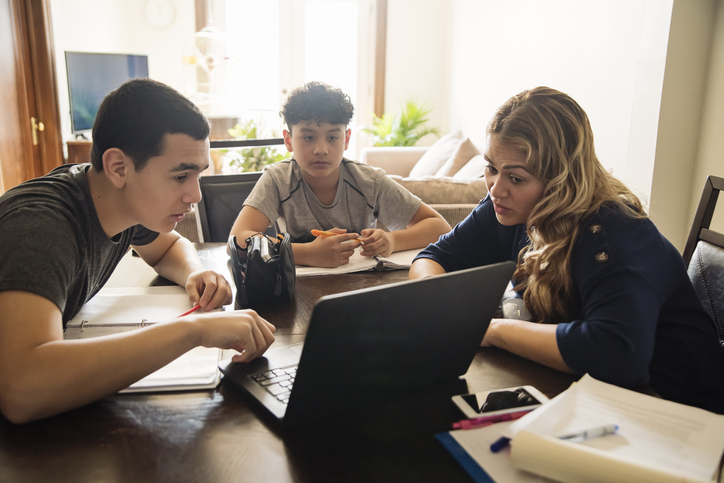Stay up-to-date with news from Extension's family educators to help you meet your financial goals.
Money-smart choices start at home
April is financial capability month, a nationwide initiative to raise awareness about the importance of making money-smart choices. In today’s digital world, youth are bombarded with opportunities — and many involve money. It’s no wonder that even young adults still turn to their parents and caregivers for financial advice and guidance. Although it may seem complicated, start with the A-B-C’s of money-smart choices:
- A stands for awareness. Whether we know it or not, many of the everyday choices we make involve money. A first step is helping young people recognize that money is a means for attaining goals that are important to them and to their family.
- B stands for balance. Every family has responsibilities and goals. When youth understand that money is needed to pay for necessary things like food and shelter, as well as fun things like sports gear or video games, they learn to weigh the pros and cons before making choices.
- C stands for conversation. Engaging youth in ongoing and age-appropriate conversations, helps youth to understand what is important and why.
Activities to teach families and youth about finances
There are many ways to start talking with young people about money. Below you'll find conversation starters, short videos, games and educational tools to help make smart-money choices.
Family (all ages)
You can download and print, Money Conversation Starters, a family activity to help you start some important conversations with child(ren) about money. Help them learn about your money values and guide them as they develop their own. Avoid lecturing. Cut apart the questions below. Fold them in half and put them in a small dish or plastic bag. Use one question at mealtime, at family meetings, during a long trip, while you're washing dishes together or while you're in line at the grocery store.
We invite parents and caregivers to sign up to receive two text messages a week throughout the school year on topics of health and nutrition, developmental affirmations, parenting and school engagement, mental health and well-being and financial capability. These text messages are designed to support you and your family as you are faced with making many and varied daily parenting decisions. You can choose to receive messages in English or Spanish.
Sign up to receive U Got This! text messages. This program is free, but be aware some fees may apply depending on your cellphone service provider.
What's the difference between saving and investing? Learn more about how you can plan for emergencies, short-term and long-term financial goals. Saving and investing for your future is an educational resource for youth and adults.
Younger children (learners K-4th grade)
Money as you grow bookshelf is a great resource from the Consumer Financial Protection Bureau (CFPB) that helps parents weave money skills into the time you may already spend reading with your children at home and helps bring money topics to life through storytime. This resource provides an extensive list of books for children ages four to ten and a reading guide for each book to help parents explain the key money ideas covered in the book and suggests questions to ask during the reading time. In addition, each guide provides information on activities to do with your children after the book is finished to support the money concepts.
Youth (learners 5th-12th grade)
Booshke Giin (It’s up to you, it’s your decision!) is a creative approach to involve American Indian youth in active learning experiences that make financial education concepts relevant to their everyday decisions. The Booshke Giin lessons attempt to push aside mainstream ways in favor of storytelling to teach core financial concepts. The approach and the lessons are adaptable for other youth audiences and combines personal finance concepts and American Indian legend stories. The lessons are based on Ojibwe and other tribal legend stories, to reinforce financial concepts and incorporate Ojibwe vocabulary and cultural information. Youth are able to reflect on the story to make a meaningful personal connection between the financial concept and their own culture.
Make Money Make Sense is designed to engage youth in activities to help them discover how money works and how to make better choices. The activities can be used in after-school programs - but are a good way to get parents and children talking and have that “Money Moment!” Try these with youth in elementary and middle school.
Young adult (learners in high school- young adult)
Financial capability videos about credit
Start your financial capability journey by checking out these short videos to learn more about credit:
Credit and why it matters
Credit scoring criteria
The Fair Credit Reporting Act
Fixing credit report errors
Financial capability videos about budgets
Start your financial capability journey by checking out these short videos to learn more about budgets:
Needs and wants
Smart goals
Track your spending
Creating a spending plan
Are you the parent or caregiver to a college student, or one heading off to college soon? Having ongoing conversations about money is so important! Here are some resources to have that “money moment” with your young adult.
Renter 101 is a free online course for those that want to learn the skills to become a successful renter. Consider taking it with a young person or someone seeking a fresh start with safe and affordable housing.
Sign up and stay connected
Reviewed in 2024




